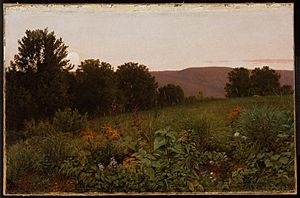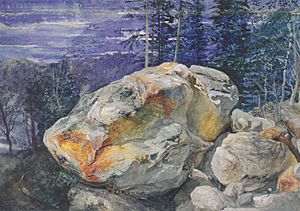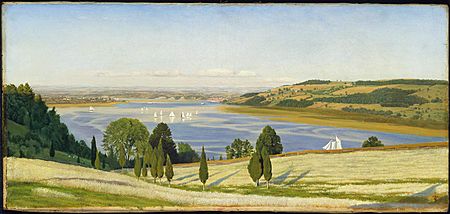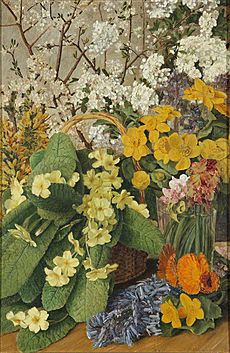American Pre-Raphaelites facts for kids

William Trost Richards, Sunset on the Meadow, 1861, oil on canvas
|
|
| Years active | c. 1857–1867 |
|---|---|
| Country | United States |
| Major figures | Thomas Charles Farrer, William James Stillman |
| Influences | John Ruskin, William Henry Hunt, Dante Gabriel Rossetti, Thomas Cole |
The American Pre-Raphaelites were a group of landscape painters in the United States. They were active in the mid-1800s. Their name came from their connection to the Pre-Raphaelite Brotherhood in England. They were also greatly influenced by the art critic John Ruskin.
Painter Thomas Charles Farrer was a leader of this group. Many members also supported the movement to end slavery, known as abolitionism. This art movement didn't last very long. It mostly ended by 1870.
The American Pre-Raphaelites painted in a very clear and realistic style. Unlike their English friends, they mostly painted landscapes and still lifes. They did not often paint people. In the 1860s, they really pushed for paintings of nature and everyday objects.
How the Movement Started
The ideas of English art critic John Ruskin became popular in the United States. This happened after his book Modern Painters came out in 1843. Ruskin believed in painting outdoors, directly from nature. This idea fit well with American Transcendentalist beliefs.
Many painters and writers, like Ralph Waldo Emerson, read Modern Painters. Artist Worthington Whittredge said the book was "in every landscape painter's hand." Magazines like The Crayon, started by William James Stillman in 1855, also helped share the ideas of the English Pre-Raphaelite Brotherhood.
After visiting England, William Stillman joined a group of artists. They met at the home of Henry Kirke Brown in Brooklyn. People started calling them "The American Pre-Raphaelites." In 1857, an art show in New York displayed British art. This show helped spread Pre-Raphaelite ideas even more. It included works like Ruskin's own Fragments of the Alps.
In 1860, painter Thomas Charles Farrer moved to the US from England. He had studied with Ruskin himself. Farrer brought new energy to the movement. On January 27, 1863, he and six friends started a group. They called it the Association for the Advancement of Truth in Art.
Since The Crayon magazine had stopped, this new group started their own magazine. It was called The New Path. It was published every month from May 1863 to December 1865. The New Path often printed articles that criticized other artists. It supported the very detailed and "truthful" artworks that the Pre-Raphaelites and Ruskin liked.
Many American Pre-Raphaelites had been part of the Hudson River School movement. But they later disagreed with its style. They felt the Hudson River School painted landscapes that were too perfect or "idealized." The New Path was known for its sharp criticism. For example, it criticized painters like Albert Bierstadt. They felt his landscapes supported ideas of American expansion, known as manifest destiny.
After The New Path stopped being published, the movement began to fade. By 1870, it had mostly ended. The American Civil War caused a lot of changes, which was one reason. Also, painting outdoors in great detail was very demanding. This led many American Pre-Raphaelites to try different styles. For example, William Trost Richards later became a marine painter, focusing on ocean scenes.
What Their Art Looked Like
Like the English Pre-Raphaelites, the American group made very detailed paintings. They focused on showing nature exactly as it was. William Stillman once spent three months painting a single violet in a painting! This shows how much they cared about tiny details.
They often criticized artists like Albert Bierstadt. They felt Bierstadt didn't study his subjects enough before painting. They believed an artist should do many sketches and studies.
Because they focused so much on reality, the group was sometimes called "Realists." They were against the traditional art taught in academies. They believed in showing "visual truth" instead of made-up scenes. One critic said their art showed "a huge amount of detail, turning nature into decoration."
Over time, some people criticized the American Pre-Raphaelites. They said the art was "unimaginative." They felt the artists followed Ruskin's ideas too closely. Ruskin believed art should not show too much emotion.
While they copied the English Pre-Raphaelites' focus on nature, the American artists did not paint moral scenes or medieval stories. The American artists often painted "rustic, informal" landscapes and still lifes. They especially liked painting birds' nests!
Artists and Writers in the Movement
- Mary Louise Booth
- Henry Kirke Brown
- Fidelia Bridges
- Clarence Cook
- Henry Farrer
- Thomas Charles Farrer
- John William Hill
- Clarence King
- Charles Herbert Moore
- Henry Roderick Newman
- William Trost Richards
- William James Stillman
- Russell Sturgis
- Sarah Tuthill
- Peter Bonnett Wight




